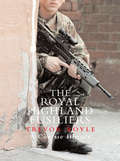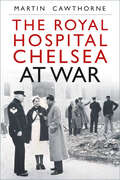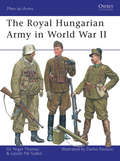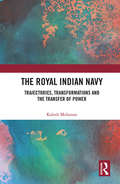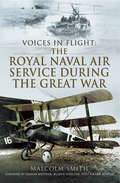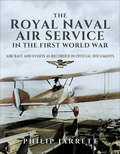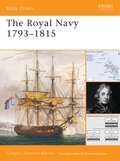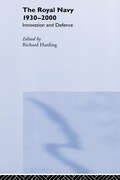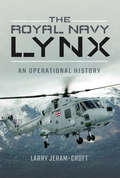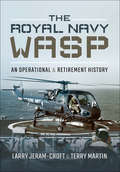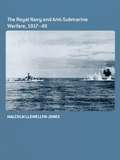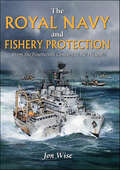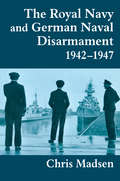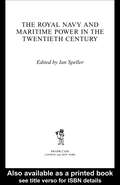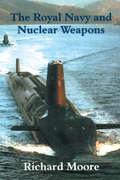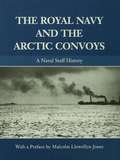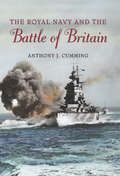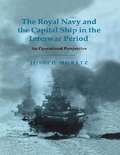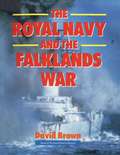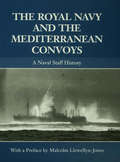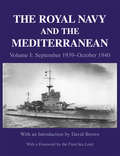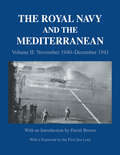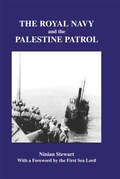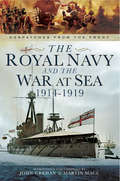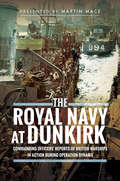- Table View
- List View
The Royal Highland Fusiliers: A Concise History
by Trevor RoyleThe Royal Highland Fusiliers came into being in 1959 as a result of the amalgamation of two regiments, both of which had strong connections with Glasgow and the west of Scotland: The Royal Scots Fusiliers, founded in 1678 by Charles Erskine, fifth Earl of Mar; and The Highland Light Infantry, or HLI, created in 1881 as a result of the amalgamation of the 71st Highlanders and the 74th Highlanders. Two distinctive infantry traditions can be found in the names of these regiments, which have helped to form the line infantry regiments of the British Army. Fusiliers were armed with the flintlock fusil instead of the more common matchlock musket, and light infantry came into being during the Napoleonic Wars to provide the army with a corps of skirmishing sharpshooters similar to Austrian and German Jäger troops.Amongst those who have served as fusiliers or light infantrymen are Hugh Trenchard, who became Air Chief Marshal of the Royal Air Force, Winston Churchill and David Niven, who joined the HLI from Sandhurst in the inter-war years. All these traditions and personalities went into the making of a regiment whose name lives on in the 2nd battalion of The Royal Regiment of Scotland, which was formed in 2006 as a result of the restructuring of the infantry regiments of the British Army.
The Royal Hospital Chelsea at War
by Martin Cawthorne‘Underpinned by rigorous academic research, (Martin Cawthorne) has crafted a highly readable narrative which brings to life the characters, events, the dilemmas facing the authorities and the enduring resilience of the Royal Hospital’s Pensioners.’ – General Sir Adrian Bradshaw, KCB, OBE, DL, Governor, Royal Hospital ChelseaIn May 1938 a confidential meeting was held between Officers of the Royal Hospital Chelsea and government departments responsible for civil defence planning. All participants agreed that, should war come, the 500 Chelsea In-Pensioners residing at the Royal Hospital should be evacuated to a place of safety outside London. However, toxic politics and complex logistics meant that, on the outbreak of war in September 1939, only fifty were evacuated, to a country house in Herefordshire. The remainder, many carrying physical and psychological scars from the First World War, sought sanctuary in hastily constructed air-raid shelters and awaited their fate.Using recently uncovered archive material, some stored for decades in an attic at the Royal Hospital, Martin Cawthorne chronicles the story of Chelsea’s old soldiers, once more in the line of fire as they faced the horrors of the London Blitz.
The Royal Hungarian Army in World War II
by Nigel Thomas Darko PavlovicThe Royal Hungarian Army was Germany's largest ally on the Eastern Front during World War II (1939-1945), providing a vital contribution in terms of both men and equipment. Information about the Hungarian Army in English is rare, and in this book co-authors Nigel Thomas and Hungarian expert Laszlo Szabo fill in the gaps about an important German ally.Deployed in Ukraine at the beginning of the war, the Hungarian Army were involved in a number of brutal encounters with the Red Army, including stubborn resistance in Transylvania in the summer of 1944 and the brave defence of Budapest in the face of overwhelming odds. The Hungarian Army was a varied and colorful force, ranging from mountain troops and tank units to horse cavalry and specialist infantry. All of these are illustrated in full color artwork, and the text is full of details about the Hungarian Army's own, quite distinct uniforms and insignia as well as many of its own weapons and tanks. With so little of this information readily available outside of Hungary, this is an essential starter resource for war gamers, modelers, re-enactors and military historians.
The Royal Indian Navy: Trajectories, Transformations and the Transfer of Power
by Kalesh MohananThis book presents a comprehensive history of the Royal Indian Navy (RIN). It traces the origins of the RIN to the East India Company, as early as 1612, and untangles the institution’s complex history. Capturing various transitional phases of the RIN, especially during the crucial period of 1920–1950, it concludes with the final transfer of the RIN from under the British Raj to independent India. Drawn from a host of primary sources—personal diaries and logs, official reports and documents—the author presents a previously unexplored history of colonial and imperial defence policy, and the contribution of the RIN during the World Wars. This book explores several aspects in RIN’s history such as its involvement in the First World War; its status in policies of the British Raj; the martial race theory in the RIN; and the development of the RIN from a non-combat force to a full-fledged combat defence force during the Second World War. It also studies the hitherto unexplored causes, nature and impact of the 1946 RIN Revolt on the eve of India’s independence from a fresh perspective. An important intervention in the study of military and defence history, this will be an essential read for students, researchers, defence personnel, military academy cadets, as well as general readers.
The Royal Naval Air Service During the Great War (Voices in Flight)
by Malcolm SmithFollowing in the same style as his previous book of Fleet Air Arm recollections, Malcolm Smith has collected a compendium of reminiscences from pilots who flew for the Royal Navy and the Royal Marines during the First World War. He includes first-hand testimonies from pilots manning early seaplane stations, an enthralling account from F.J. Rutland (the 'Rutland of Jutland'), who became the first pilot to take off in a Sopwith Pup from a platform on the roof of one of HMS Yarmouth's gun turrets, the true tale behind Rudyard Kipling's short story 'A Flight of Fact' (concerning Guy Duncan-Smith's experience of becoming marooned in the Maldives following a dramatic shoot-down), amongst many other personalized and illuminating stories. All these anecdotes are drawn from the extensive archive maintained by the Fleet Air Arm Museum at Yeovilton, Somerset. The archive contains an enormous quantity of material, in the form of handwritten diaries, transcripts, log books and documentation of many kinds. Alongside the written material, the Museum maintains an unrivaled photographic archive and a representative sample of these images is included in the book.Excerpts from diaries, transcripts of spoken first-hand accounts and other recorded narratives make up the bulk of the book, with whole chapters dedicated to some of the most vocal members to see service during the course of the RNAS's Great War history. Guy Leather, a pilot destined to track an impressive trajectory with the RNAS features in one such chapter; his day to day accounts relay the full gamut of pilot experience at this time. This humane and thoughtful consolidation of pilot reflections is sure to appeal broadly, particularly as we approach the one hundredth year anniversary of the First World War.
The Royal Naval Air Service in the First World War: Aircraft and Events as Recorded in Official Documents
by Philip JarrettThis book makes five original documents relating to the work of Britain's Royal Naval Air Service (RNAS) during the First World War readily available to students and historians. To enhance visual interest a large collection of photographs, many hitherto unpublished, has been added. Some of these relate directly to the aircraft and events mentioned in the documents, but others show developments before and after the periods covered. The five documents concerned are the Diary of Important Operations, Flanders, 1916; Disposition of Aircraft, 24 February, 1917; Royal Naval Air Service Communiques Nos 1 to 14; Truing-up of Aeroplanes: Issued by the Air Department on 1 September 1916; and The Grain drawings, a unique set of sketches and drawings made by a draughtsman at the RNAS seaplane repair station at Port Victoria, Isle of Grain, in Kent during the Great War.All of these documents offer an array of fascinating insight into Royal Naval Air Service practices during the Great War. Much of the content on display has never been printed before. This unique treasure trove of visual reference is sure to appeal to all serious First World War historians, students and enthusiasts.
The Royal Navy 1793-1815
by Gregory BarnesBy the end of the Napoleonic Wars in 1815 Britain was the undisputed master of the seas owing to the power and strength of the Royal Navy. Its fleets, comprising ships of the line, frigates, and gunboats, had doubled in size since the outbreak of the French Revolutionary Wars in 1793, totaling almost a thousand capital vessels. This book examines the commanders, men, and ships of the Royal Navy during the French Revolution and Napoleonic wars, and discusses the Navy's command structure (from the Admiralty down to ship level) and its organization at sea. The tactics employed in action by a fleet, a squadron, and individual ships are also discussed, as are the medical services available, providing a fascinating insight into the navy that ruled the waves.
The Royal Navy 1930-1990: Innovation and Defense
by Richard HardingThis new book explores innovation within the Royal Navy from the financial constraints of the 1930s to World War Two, the Cold War and the refocusing of the Royal Navy after 1990. Successful adaptation to new conditions has been critical to all navies at all times. To naval historians the significance and process of change is not new, but in r
The Royal Navy Lynx: An Operational History
by Larry Jeram-CroftThis book tells the story of an incredibly capable naval aircraft, based primarily on the words of those who flew and maintained it. Beginning with the Lynx's entry into service in 1976, it goes on to discuss its remarkable performance in the Falklands War. Here it was used in both its primary roles of anti-submarine and anti-surface warfare, as well as several others for which it had never been designed, such as Airborne Early Warning and anti-Exocet missile counter measures. The Lynx has been continuously employed in the Gulf from 1980 until the present day. What is not generally known is the fact that these aircraft were responsible for effectively destroying the Iraqi navy, sinking over fifteen warships in a matter of a weeks. All related operational details are included here.Also included are accounts of operations conducted around the world, including anti-drug interdiction, Arctic deployments, Search and Rescue, hurricane relief, as well as a few notable mishaps. Also described is the development of the aircraft from the Mark 2 to the current Mark 8 (SRU), bringing the narrative fully up to date. Although only a snapshot, the stories narrated here offer the reader a real understanding of the capabilities of an aircraft with a truly remarkable history of service.
The Royal Navy Wasp: An Operational & Retirement History
by Terry Martin Larry Jeram-CroftThis book tells the story of the first helicopter in the world designed from the outset to be deployed at sea, in Destroyers and Frigates. It is primarily based on the words of those who operated it. Designed from the outset to cope with the restricted space of a warship both for stowage and flight operations it proved an immediate success. Its original role was to act as a weapon carrier to launch torpedoes and depth charges on submarine contacts out of range of the parent ships weapons range. Soon, it also took on a second primary role of air to surface attack using wire guided missiles. The flexibility of the machine was such that it was able to conduct a plethora of secondary roles from visual search to collecting the all-important ships mail. Wherever the Royal Navy was deployed on operations a Wasp was there. The book has accounts of operations around the world particularly during the Cold War of the Seventies and the Falklands War where amongst other things it had the honour of being the first RN platform ever, to fire a guided missile at a surface target.However the story doesnt end there. Although the aircraft went out of service in the Royal Navy in 1988, it continued to operate with other navies around the world. To this day there are still several airworthy examples flying. The second part of the book gives accounts of these machines and brings the story of the Wasp completely up to date.
The Royal Navy and Anti-Submarine Warfare, 1917-49 (Cass Series: Naval Policy And History Ser. #Vol. 37)
by Malcolm Llewellyn-JonesAn essential new account of how anti-submarine warfare is conducted, with a focus on both historic and present-day operations. This new book shows how until 1944 U-boats operated as submersible torpedo craft which relied heavily on the surface for movement and charging their batteries. This pattern was repeated in WWI
The Royal Navy and Fishery Protection: From the Fourteenth Century to the Present
by Jon WiseFrom the first recorded mention of British ships protecting of fishing vessels in the late fourteenth century through to recent controversies over the change in emphasis to border patrols and overseas deployments, the story of the Royal Navy’s ‘Cinderella Fleet’ involves many dramatic incidents; until now, however, there has never been a book dedicated to the subject. Naval historian Jon Wise’s new work will rectify this omission. Historically there have been two main reasons why protecting fishing vessels was so important: first, fish have always constituted an essential part of the nation’s diet while, secondly, fishermen have been an important source of skilled personnel for the Royal Navy itself. It is claimed that the Fishery Protection Squadron (FPS) is the oldest in the fleet, pre-dating the formal creation of the Navy itself in the early part of the sixteenth century, yet it still remains comparatively little-known. The Squadron’s most famous operations were the ‘Cod Wars’ of 1958–76, but for six centuries it has been engaged in the many important tasks of protection and policing of fishing fleets, though more recently it has turned its attention to patrolling oil and gas fields, overseeing quotas and sustainability, and policing the ongoing disagreements over who can fish where and when. The author covers subjects as diverse as the battles with the Dutch for dominance in the North Sea, the protection of fishing on the eastern seaboard of America, and the role of the Squadron in the two World Wars. Containing many first-hand accounts, this thought-provoking narrative will be of particular interest to all those RN personnel who have served in the Squadron, and is set to become the definitive account of this vital but often unsung component of Britain’s naval forces, and its impact on national life.
The Royal Navy and German Naval Disarmament 1942-1947 (Cass Series: Naval Policy and History #Vol. 4)
by Chris MadsenAfter the bitter lessons of German self-disarmament in 1919, Britain was far more alert and focused when it came to overseeing the disarmament of Germany's naval forces after World War II. This book shows how well-prepared the British were second time around.
The Royal Navy and Maritime Power in the Twentieth Century (Cass Series: Naval Policy and History)
by Ian SpellerThis book adopts an innovative new approach to examine the role of maritime power and the utility of navies. It uses a number of case studies based upon key Royal Navy operations in the twentieth century to draw out enduring principles about maritime power and to examine the strengths and limitations of maritime forces as instruments of national policy. Individual chapters focus on campaigns and operations from both World Wars and a series of post-1945 crises and conflicts from the Palestine Patrol in the 1940s to Royal Navy operations in support of British policy in the 1990s. Each case study demonstrates critical features of maritime power including: operations during the transition to war; fleet operations in narrow seas; logistics; submarine operations; the impact of air power on maritime operations; blockade; maritime power projection; amphibious warfare; jurisdictional disputes and the law of the sea; and, peace support operations. The contributors to this book all have considerable experience lecturing on these issues at the United Kingdom Joint Services Command and Staff College, where maritime campaign analysis is used to teach the principles of maritime power to officers of the Royal Navy. The book combines an authoritative examination of critical Royal Navy operations during the twentieth century with a sophisticated analysis of the nature of maritime power. As such it is of both historical interest and contemporary relevance and will prove equally valuable to academic historians, military professionals and the general reader.
The Royal Navy and Nuclear Weapons (Cass Series: Naval Policy and History)
by Richard MooreThis work examines British thinking about nuclear weapons in the period up to about 1970, looking at the subject through the eyes of the Royal Navy, in the belief that this can offer new insights in this field. The author argues that the Navy was always sceptical about nuclear weapons, both on practical grounds and because of wartime and pre-war experiences. He suggests that this scepticism can teach us a good deal about military technological innovation in general.
The Royal Navy and the Arctic Convoys: A Naval Staff History (Naval Staff Histories)
by Malcolm Llewellyn-JonesPublished here for the first time, this volume presents a superb range of insights into this crucial effort of the Second World War. This Naval Staff History describes the vital role of the Arctic Convoys, 1941-1945 and was first issued by the Historical Section of the Admiralty as a confidential study for use within the Royal Navy in 1954. It grew out of the earlier Battle Summary No. 22 compiled by Commander J. Owen of the Admiralty’s Historical Section and issued in 1943 to cover the convoys run to North Russia in the last half of 1942 and early 1943. That wartime Battle Summary was subsequently revised and expanded by Commander L.J. Pitcairn-Jones to include all the main convoys run from August 1941 until the end of the war using all the historical records which were at hand after the war. A new preface provides additional context for the convoys, highlighting support provided to Russian forces in their struggle against Germany, for the original Staff History was narrowly focused on the naval aspects of the Arctic Convoys to Russia. This is an excellent resource for all students with a particular interest in the Arctic Convoys, the Second World War and in maritime and military history.
The Royal Navy and the Battle of Britain
by Anthony J. CummingThis persuasive study attacks the key myths surrounding the Battle of Britain to revise the relative status of maritime and aviation factors in the defense of Britain. Without denigrating the heroism of the fighter pilots, Anthony Cumming challenges the effectiveness of the Royal Air Force in 1940 and gives the Royal Navy much greater prominence than others have. He vigorously asserts the ability of British warships to frustrate German plans for Operation Sea Lion and to repel Luftwaffe attacks. The author argues that the RAF took the lion s share of the glory only because its colorful image could easily be used to manipulate American opinion. Cumming contends that the 70th anniversary of the Battle of Britain should celebrate the contributions of the many rather than focusing on the pilot elite, an assertion certain to provoke discussion.
The Royal Navy and the Capital Ship in the Interwar Period: An Operational Perspective (Cass Series: Naval Policy and History #Vol. 15)
by Joseph MoretzJoseph Moretz's innovative work focuses on what battleships actually did in the inter-war years and what its designed war role in fact was. In doing so, the book tells us much about British naval policy and planning of the time. Drawing heavily on official Admiralty records and private papers of leading officers, the author examines the navy's operational experience and the evolution of its tactical doctrine during the interwar period. He argues that operational experience, combined with assumptions about the nature of a future naval war, were more important in keeping the battleship afloat than conservatism in Navy.
The Royal Navy and the Falklands War
by David BrownThis military history reveals the untold story of the United Kingdom&’s Royal and Merchant Navies during the Falkland&’s War. Soldiers and journalists alike wasted no time in memorializing the campaign to recapture the Falkland Islands after the Argentinian invasion in April, 1982. With the overwhelming focus on the role of the Army, the vital contributions of the Royal and Merchant Navies have been largely overlooked. Yet no British military forces would have been there at all had the Royal Navy not provided the necessary transport, not to mention air cover and bombardment support. In this book, naval historian David Brown tells the extraordinary story of how the fleet was assembled. Merchant-ships ranging from luxury liners such as the SS Canberra to cargo-carriers of every description were quickly converted to their new role as STUFTs, or Ships Taken Up From Trade. Brown describes the stupendous problems presented by the assembling and stowing of the thousands of tons of stores and equipment needed by the Expeditionary Forces and the way in which these problems were solved.
The Royal Navy and the Mediterranean Convoys: A Naval Staff History (Naval Staff Histories)
by Malcolm Llewellyn-JonesThis book contains the Naval Staff History originally issued by the Admiralty in 1957 as a confidential book for use within the Royal Navy. It has since been declassified and is published here for the first time, along with an extended preface. This volume describes the dangerous convoy operations in the Mediterranean which were necessary to relieve the garrison and people of Malta, covering the period from the beginning of 1941 until the end of 1942. These convoys had to be fought through against determined attack by German and Italian surface, submarine and, particularly, air forces. Although casualties were proportionately higher than in Atlantic convoys, Malta was successfully re-supplied and remained a considerable impediment to enemy’s attempts to supply their armies in North Africa. These operations reveal the dedication, courage and professionalism of the sailors (of both naval and merchant services) as well as the airmen who supported them. A new preface sets the scene for the Staff History. The Royal Navy and the Mediterranean Convoys will be of great interest for students interested in the Mediterranean Convoys, Second World War and naval and military history.
The Royal Navy and the Mediterranean: Vol.I: September 1939 - October 1940 (Naval Staff Histories)
by David BrownThis volume deals with the first 15 months of the Mediterranean Campaign including the preparations for war, the effect of the entry of Italy into the war in June, 1940, the tragic actions against the French Fleet, and the achievement of British command of the sea, which was the defining factor for all subsequent Mediterranean operations. It ends with the first Mediterranean convoy battle to run supplies from Gibraltar to Alexandria - Operation Hat.
The Royal Navy and the Mediterranean: Vol.II: November 1940-December 1941 (Naval Staff Histories)
by David BrownThis work covers a difficult period of the war for the Royal Navy's Mediterranean Fleet. It covers the destruction of the Italian Fleet at Taranto by naval aircraft from the carrier Illustrious, and the entry of the German Luftwaffe into the theatre with their attack on Illustrious in 1941.
The Royal Navy and the Palestine Patrol (Naval Staff Histories)
by Ninian StewartThis is an entirely new Naval Staff History covering the period immediately after the Second World War and the Royal Navy operations to prevent illegal Jewish immigration into Palestine, at the time under British Mandate from the United Nations. The Palestine Patrol, as it became known, illustrates clearly the problems facing navies conducting operations other than war; in particular those involving maritime embargo measures.
The Royal Navy and the War at Sea, 1914–1919: Despatches From The Front (Despatches From The Front Ser.)
by Martin MaceGermany's attempts to build a battleship fleet to match that of the United Kingdom, the dominant naval power on the 19th-century and an island country that depended on seaborne trade for survival, is often listed as a major reason for the enmity between those two countries that led to the outbreak of war in 1914. Indeed, German leaders had expressed a desire for a navy in proportion to their military and economic strength that could free their overseas trade and colonial empire from dependence on Britain's good will, but such a fleet would inevitably threaten Britain's own trade and empire.Despite this backdrop of large standing navies, naval warfare in the First World War was mainly characterized by the efforts of the Allied powers, with their larger fleets and surrounding position, to blockade the Central Powers by sea, and the efforts of the Central Powers to break that blockade or to establish an effective blockade of the UK with submarines and raiders. Indeed, the use of the former saw naval conflict enter a new era, one that affected every member of the British population and, in 1917, raised the spectre of a German victory.This unique collection of original documents will prove to be an invaluable resource for historians, students and all those interested in what was one of the most significant periods in British military history.Despatches in this volume include those relating to the events at Antwerp in 1914, Royal Navy armoured car squadrons, the Battle of Dogger Bank, the Battle of the Falklands, the Battle of Heligoland Bight, minesweeping operations, Royal Naval Air Service operations and attacks, and, of course, the Battle of Jutland.
The Royal Navy at Dunkirk: Commanding Officers' Reports of British Warships In Action During Operation Dynamo
by Martin MaceThe fact that the British Expeditionary Force was evacuated from Dunkirk in May-June 1940 has achieved the status of a legend. Whilst the part played by the Little Ships in that miracle is equally well known, the role of the Royal Navys warships the destroyers, minesweepers and personnel ships is often overlooked. Indeed, more than 300,000 troops out of a total of 338,226, were evacuated from the harbour at Dunkirk in these vessels.In the weeks after Operation Dynamo, the Admiralty issued an order requiring the Commanding Officers of those British warships involved to submit a report detailing their actions. Described in their own words, with the events still fresh in their minds, the result is a vivid record of the chaos, improvisation, skill and bravery that all combined to rescue the basis of an army that helped carry Britain through the dark months and years that followed. It is a record that forms the basis of this book.
